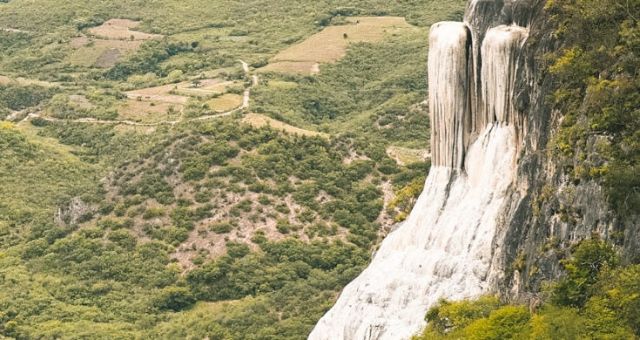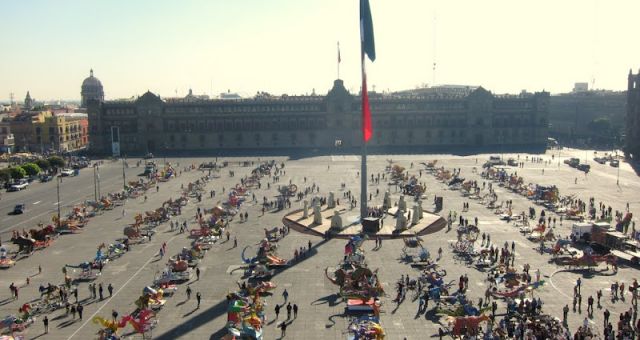My mom’s visit from Indonesia coincided with the Day of the Dead celebration week. As I was planning her visit, I thought going to Oaxaca, arguably the place to be to celebrate Dia de Los Muertos, would be a good bonding experience. (Also, I just saw the movie, “Coco”, which was an awesome movie – go see it if you haven’t – AND I’m always looking for a reason, any reason, to go back to Mexico.)
Well, not only was the trip a good bonding experience, celebrating Dia de Los Muertos in Oaxaca was the most beautiful cultural experience I’ve ever had. As someone who considers herself a cultural ignoramus, I don’t say that lightly.
Painted faces. A common sight during Dia de Los Muertos celebration in Oaxaca.
What is Dia de Los Muertos?
Once upon a time, I used to think that Día de los Muertos, or Day of the Dead, is a Mexican version of Halloween. Now I know better. There are similarities but the two events differ in a lot of ways. Halloween and Dia de Los Mueros are both based on the idea that the spirits return at that time of year. The main difference lies in how the spirits are perceived.
While fear is the main driving force for Halloween (the spirits are supposed to be malevolent), joy is the theme of Dia de Los Muertos because the returning spirits are beloved family members. To welcome back these long lost relatives, Dia de Los Muertos is celebrated with an explosion of colors, candles, parades, and street parties.
The root of Day of the Dead comes from pre-hispanic culture: the Aztec and the Toltec where the dead were still seen as members of community. When the Spanish came, this custom was absorbed and integrated into the Catholic’s All Saints Day (Nov 1) and All Souls Day (Nov 2), which is why the Day of the Dead is now celebrated on those days. It’s an example of a merging and integration between an incoming and an existing culture.
Things You’ll See During Dia de Los Muertos in Oaxaca:
Day of the Dead celebration in Oaxaca is a colorful, joyful festivity.
Ofrenda
Ofrendas are altars containing the favorite foods and beverages of the departed, built in homes and cemeteries. These altars are not meant for worshipping but instead to encourage the departed souls to visit the realm of the living. An ofrenda might have several tiers and besides food and drinks, you might also find family photos or mementos. One element that’s commonly found on ofrendas are marigold flowers that are meant to guide the souls from the gravesite to the altar.
The Calavera Catrina
La Catrina is a female skeleton who is dressed in the style of French upper-class women. There was even a Catrina contest. We didn’t see it, but saw elaborately dressed Catrinas on their way to the event.
Dia de Los Muertos Food
Pan de muerto, or bread of the dead, is a type of sweet bread with decorative heads stuck into it. It’s often dunked into a cup of hot chocolate for breakfast.
Sugar skulls is a tradition brought by 17th-century Italian missionaries. They come in all sorts of sizes and colors. I’m not sure if people buy them to eat or only for decorating ofrendas.
Drinks: such as atole, a thin warm porridge made from corn flour, cane sugar, cinnamon, and vanilla; and tejate, a frothy indigenous drink made of cocoa.
Sand Tapestries
Walking around Oaxaca during Day of the Dead you’ll see these sand tapestries, known as tapetes de arena. These often depict whimsical images of skeletons or religious figures.
How to Celebrate Dia de Los Muertos in Oaxaca
The array of activities in Oaxaca during this week can be overwhelming. My suggestion is to take it easy during the day: sleep in, have a lazy breakfast, do some souvenir shopping, or take short day trips… then in the afternoon, get ready. Most activities start late in the afternoon and last all night until morning the next day. The following are my suggestions on how to celebrate Day of the Dead in Oaxaca:
Top: My mom’s getting excited over a cup of tejate. Bottom: Get your face painted ala calavera
Follow the Crowd
Every evening during Dia de Los Muertos week the pedestrianized street of Calle Alcalá in front of Templo de Santo Domingo came alive with revelers in costumes, food vendors, street performers, and face painters. My mom and I had a great time mingling with the crowd and people watching. There were restaurants and bars lining the street where we would often take a break and watch the celebration unfold while sharing a plate of tlayudas or memelitas.
Street food to watch out for:
Tejate: an indigenous drink made of corn, cacao, and flor de cacao. It’s like a mildly sweet, frothy, chocolate drink. Served cold. It was so refreshing!
Frito Corn Salad: a bag of fritos mixed with fresh corn, mayonnaise, lime, tabasco, and cheese. Look for carts with bags of fritos. Tastes much better than it looks.
You’ll see a lot of ofrendas in Oaxaca during Dia de Los Muertos
Look Out for Ofrendas
You will see ofrendas everywhere just by walking around the extremely walkable downtown Oaxaca. But the biggest, most impressive ofrendas can be found in major government institutions, hotels, and restaurants. The Oaxaca library itself had 2 floors of various ofrendas.
Flower-adorned skeleton on stilts
Join a Comparsa
Comparsas or muertadas are street parades happening all over Oaxaca and the surrounding villages. Muertadas in Jalatlaco and San Augustin Etla are some of the better known ones. In 2018 the comparsa in Etla happened on Nov 1st (check your schedule).
The comparsa in Etla involves going to various houses in the village. The hosts of each house will serve food and drink to revelers (while supplies last) while live musicians play and everyone dances in their costumes adorned with bells and mirrors. Then onward to the next house. Repeat. It’s totally overwhelming, totally wild, and totally worth checking out. It can get extremely packed and crowded which leads to heavy traffic. Sort out your transportation in advance.
Scenes from Atzompa cemetery
Visit a Cemetery
Visiting a cemetery on Dia de Los Muertos was the highlight and I’d say a must-do when celebrating Day of the Dead in Oaxaca. I went to visit the cemetery in Atzompa village on Oct 31st. When I stepped inside the cemetery ground, I gasped at the spectacle of hundreds of candles placed around the altars and graves. The vibe was both solemn and festive. There was a mariachi band going around the gravesites while a live band was performing on a stage. Families were having a vigil, passing a bottle of mezcal around, and having a picnic. It was just like that cemetery scene from Pixar’s Coco! It was beautiful, and touching, and overhelming it made me want to cry.
Despite the carnival atmosphere, there were solemn, quiet moments. The most heartbreaking one to me involved lone, older women standing vigil over a gravesite. A widow? A mother? Who knows. Even though taking pictures are allowed, do try to be discreet. Also try to set aside some time to simply soak up as much of the atmosphere as you could. It was a very special experience.
Which cemetery to visit? There are 2 main cemeteries in Oaxaca as well as cemeteries in the villages around Oaxaca. One of the most commonly visited cemeteries are located in the village of Xoxocotlan (or Xoxo (pronounced “ho-ho”): the Panteon Viejo (old cemetery) and the Panteon Nuevo (new cemetery). Different cemeteries have different schedule and some are only open during the day. I was told that the cemeteries at Xoxo tend to be very crowded and that was why I went to Atzompa.
I would say that the easiest way to visit the cemeteries is with organized tours that visit 2-3 different cemeteries in one night. Or ask your hostel/hotel for more information which to visit on a particular day since it seemed to me that the details was hard to come by.
Pan de Muerto and fried crickets found at a market in Oaxaca
Visit the Markets
Visiting the markets during Dia de Los Muertos is a fun activity since this is where Oaxacaquenos buy items for their ofrendas. Here you’ll be able to see the full array of Day of the Dead offerings: sugar skulls, pan de muertos, candles, flowers, etc as well as local food such as tacos, chilies for moles, and chapulines (fried crickets).
There are two markets you can visit in Oaxaca: 20 de Noviembre market in town, or the Central de Abastos further to the south. If you’re in town on Friday, the weekly market in Ocotlan is worth visiting (watch out for pickpockets).
Hierve del Agua, a great daytrip from Oaxaca
Take Daytrips During the Day
Since most of the Dia de Los Muertos festivities happen in the evening, you can spend the day visiting places of interest in and around Oaxaca. We took daytrips to visit Hierve del Agua, Monte Alban, as well as visiting alebrijes workshops. The best way to do this is to charter a taxi for the day. The drivers usually charge 200-250 pesos per hour.
Useful Things to Know About Oaxaca’s Dia de Los Muertos:
- Getting to Oaxaca: you can either fly into Oaxaca or do what we did which was fly into Mexico City and took an ADO bus to Oaxaca. The buses in Mexico are excellent, especially if you splurge for one of the premium classes such as ADO Platinum and ADO GL.
- The “peak” celebration days are Oct 31, Nov 1 and Nov 2 but festivities take place before and after these dates. It’s considered high season in Oaxaca so make sure you book your accommodations as soon as possible.
- The weather in Oaxaca in October – November may get chilly in the evenings, so be sure to pack a sweater or light jacket. We found ourselves walking a lot, so wear comfortable shoes.
- Upon arrival, get your hand on the official schedule of Dia de Los Muertos celebration. You’ll find printed Dia de Los Muertos schedule at any hotels in Oaxaca. It will help you plan your activities. Even though you’ll definitely have a great time just walking around downtown Oaxaca in the evenings and running into random parades and celebrations, there are certain activities that you do not want to miss (e.g. muertada in San Augustin Etla, cemetery visit in Atzompa, etc). Some of these festivities might take place in suburbs or villages that require pre-arranging a transport. So heads up!
- Getting to festivity locations. Taking taxis is the easiest way to get around. Anywhere within Oaxaca should cost 40-60 pesos. Visiting barrios or villages around Oaxaca is a little bit trickier. The cheapest option is to take shared taxis or collectivos. They depart from designated stands or sitios (often it’s just a street corner) the locations of which depend on your destination. Since there’s no central point of departure it’s all a little bit confusing really. Easiest to charter a taxi where you pay per hour (usually 200 – 250 pesos/hr) including waiting time.
Where to Stay in Oaxaca for Dia de Los Muertos
In the thick of it. These hotels are right in the middle of the action which could be both a good thing and a bad thing.
- Hotel Parador de Alcala – double rooms start from $70. This highly rated hotel comes with an outdoor pool and a rooftop terrace.
- Hotel Palacio Borghese – double rooms start from $150. This beautiful hotel is one block from Templo de Santo Domingo and minutes from any Dia de Los Muertos celebration.
Short walk away. About 10-15 mins walk from the main action during Oaxaca Dia de Los Muertos, these hotels are perfect for those who need a quiet place to retreat to.
- La Betulia Bed and Breakfast – double rooms start from $90. Tucked away on a quiet corner of downtown, this charming hotel offers colorful rooms, delicious breakfast, and top notch service.
- Los Pilares Hotel – double rooms start from $75. This hotel offers spacious rooms, a heated outdoor pool, and a shady indoor courtyard. A favorite!
Books to Read
Oaxaca Journal – musings on ferns, chocolate, mescal, pre-Columbian culture and hallucinogens. Easy reading that I quite enjoyed as part of my pre-trip reading.
—
Even though this tradition started in Mexico, it is now celebrated in other parts of Latin America as well. I’m thinking maybe this year I’ll head to Guatemala, another favorite Central American country of mine, for the celebration. I just can’t get enough.
Where have you celebrated Dia de Los Muertos?




Questions and Comments
Comments are disabled. If you have any questions about the post, you can DM me on Instagram: @jacknjilltravel.